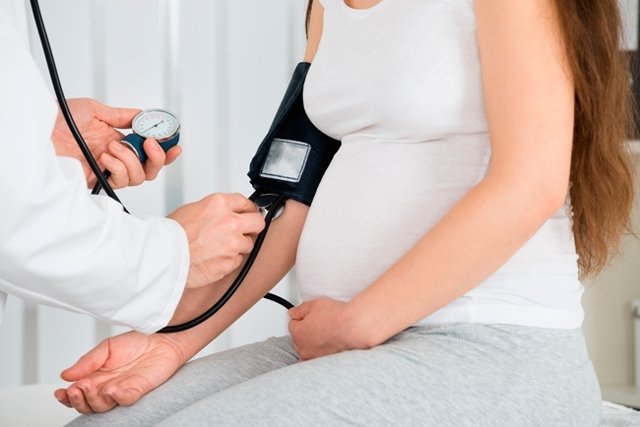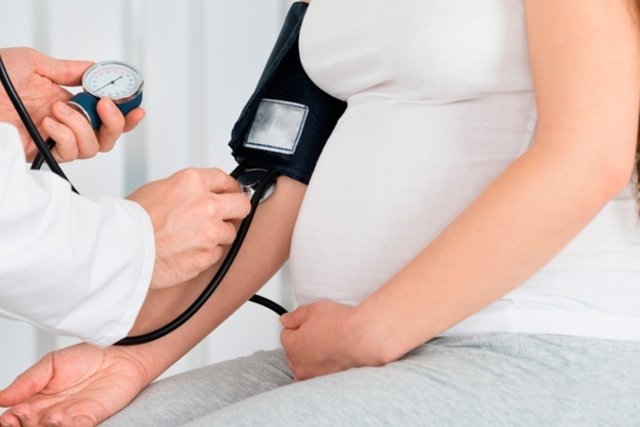Pre-eclampsia is when blood pressure is above 140 x 90 mmHg after the 20th week of pregnancy, causing changes in the liver or kidneys and symptoms such as headache or abdominal pain, in some cases.
Preeclampsia appears to be caused by problems with the development of blood vessels in the placenta and is more common in women with a history of preeclampsia, age under 17, and high blood pressure before pregnancy.
If pre-eclampsia is suspected, it is important to consult an obstetrician so that a detailed assessment can be carried out. When the diagnosis is confirmed, treatment may range from the use of antihypertensive medications to induction of labor.

Main symptoms
Preeclampsia symptoms can vary depending on the severity:
1. Mild pre-eclampsia
In mild pre-eclampsia, signs and symptoms usually include:
- Blood pressure between 140 x 90 and 160 x 110 mmHg;
- Presence of proteins in urine;
- Bloating and rapid weight gain.
If at least one of the symptoms is present, the pregnant woman should go to the emergency room or hospital to measure her blood pressure and take blood and urine tests to confirm whether or not she has pre-eclampsia.
2. Severe pre-eclampsia
Symptoms of severe preeclampsia include:
- Blood pressure greater than 160 x 110 mmHg;
- Strong and constant bilateral or frontal headache;
- Pain on the right side of the abdomen;
- Decrease in the amount of urine and the urge to urinate;
- Changes in vision, such as blurred, darkened vision or the sensation of seeing stars;
- Burning sensation in the stomach.
If the pregnant woman presents these symptoms, she should go to the hospital immediately.
Relationship between eclampsia and pre-eclampsia
Typically, eclampsia is one of the possible complications of preeclampsia, which can cause seizures without an apparent cause. The risk of eclampsia tends to be higher in the case of twin pregnancy, first pregnancy and in women over 35 years of age, for example. Understand better what eclampsia is, how to identify and treat it.
Possible causes
Pre-eclampsia appears to be caused by a problem in the development of blood vessels in the placenta, which become narrower, decreasing the ability of blood to flow properly and leading to changes in blood clotting.
Some factors that increase the risk of pre-eclampsia are:
- Family history of pre-eclampsia;
- Pre-eclampsia in a previous pregnancy;
- Restricted intrauterine growth;
- First pregnancy;
- Multiple pregnancy;
- Pregnancy after age 35;
- In vitro fertilization or other type of assisted reproduction;
- History of placental abruption;
- Tendency to develop thrombosis.
Furthermore, in the case of diseases such as diabetes mellitus, chronic kidney disease, hypertension, obesity and systemic lupus erythematosus, the risk of pre-eclampsia also tends to be higher.
How the treatment is carried out
Treatment for mild preeclampsia usually involves measures such as decreasing salt intake and increasing water intake to about 2 to 3 liters per day. Furthermore, it is important to rest, preferably lying on your left side, in order to increase blood circulation to the kidneys and uterus.
During treatment, it is important for the pregnant woman to control her blood pressure, and the doctor may recommend the use of antihypertensive medications, in addition to being recommended to carry out urine and blood tests regularly, to prevent pre-eclampsia from worsening.
In the case of severe pre-eclampsia, treatment usually involves hospitalization. The pregnant woman needs to be hospitalized to receive medications to prevent eclampsia and control blood pressure, such as magnesium sulfate and antihypertensives.
The only definitive treatment for pre-eclampsia is induction of labor, a technique that is generally used in the most severe cases and when the baby has a chance of surviving alone or in the neonatal ICU.
Risks for the baby
Pre-eclampsia, in addition to putting the baby’s life at risk, can harm its growth in the womb and increase the chances of prematurity, respiratory distress, sepsis and intraventricular hemorrhage.
Furthermore, the risk of developmental changes in childhood is greater when there is a history of pre-eclampsia.
Possible complications of preeclampsia
Some of the complications that pre-eclampsia can cause are:
- Eclampsia: It is a more serious condition than pre-eclampsia, in which there are repeated episodes of seizures, followed by coma, which can be fatal if not treated immediately.
- HELLP Syndrome: another complication characterized by, in addition to the symptoms of eclampsia, the presence of destruction of blood cells, with anemia, hemoglobin below 10.5% and a drop in platelets below 100,000/mm3, in addition to the elevation of liver enzymes, with TGO above 70U/L. Find out more details about this syndrome;
- Placental abruption: It happens when the placenta detaches from the wall of the uterus, before the baby is born, causing bleeding. This is an obstetric emergency, in which the baby must be born as quickly as possible, by cesarean section;
- Bleeding: occur due to the destruction and decrease in the number of platelets, and impairment of clotting capacity;
- Acute lung edema: situation in which there is a collection of fluid in the lungs;
- Liver and kidney failure: which may even become irreversible;
- Baby prematurity: a situation that, if it is serious and without adequate development of its organs, can leave consequences and compromise its functions.
These complications can be avoided if the pregnant woman undergoes prenatal care during pregnancy, as the disease can be identified early and treatment can be carried out as quickly as possible.
A woman who has had pre-eclampsia can become pregnant again, and it is important that prenatal care is carried out strictly, in accordance with the obstetrician’s instructions.
Common questions
Some common questions about preeclampsia include:
1. What tests identify pre-eclampsia?
Pre-eclampsia is usually initially suspected by measuring blood pressure. However, other tests are necessary to confirm the diagnosis, such as a urine test, blood count and measurement of liver enzymes, urea and creatinine in the blood. Find out what it means when creatinine is altered.
2. Can postpartum pre-eclampsia happen?
Some women may develop postpartum pre-eclampsia, which is most common within 6 weeks of the birth of the baby. Furthermore, the risk tends to be greater when there were already changes in blood pressure before birth, in cases of maternal age over 35 years, obesity or cesarean section, for example.
3. Can pre-eclampsia happen even with normal blood pressure?
Pre-eclampsia typically happens when blood pressure is high. However, there is a higher risk of women with gestational hypertension developing pre-eclampsia despite appropriate treatment. Understand better what gestational hypertension is and the risks.

Sign up for our newsletter and stay up to date with exclusive news
that can transform your routine!
Warning: Undefined array key "title" in /home/storelat/public_html/wp-content/plugins/link-whisper-premium/templates/frontend/related-posts.php on line 12
Warning: Undefined array key "title_tag" in /home/storelat/public_html/wp-content/plugins/link-whisper-premium/templates/frontend/related-posts.php on line 13




